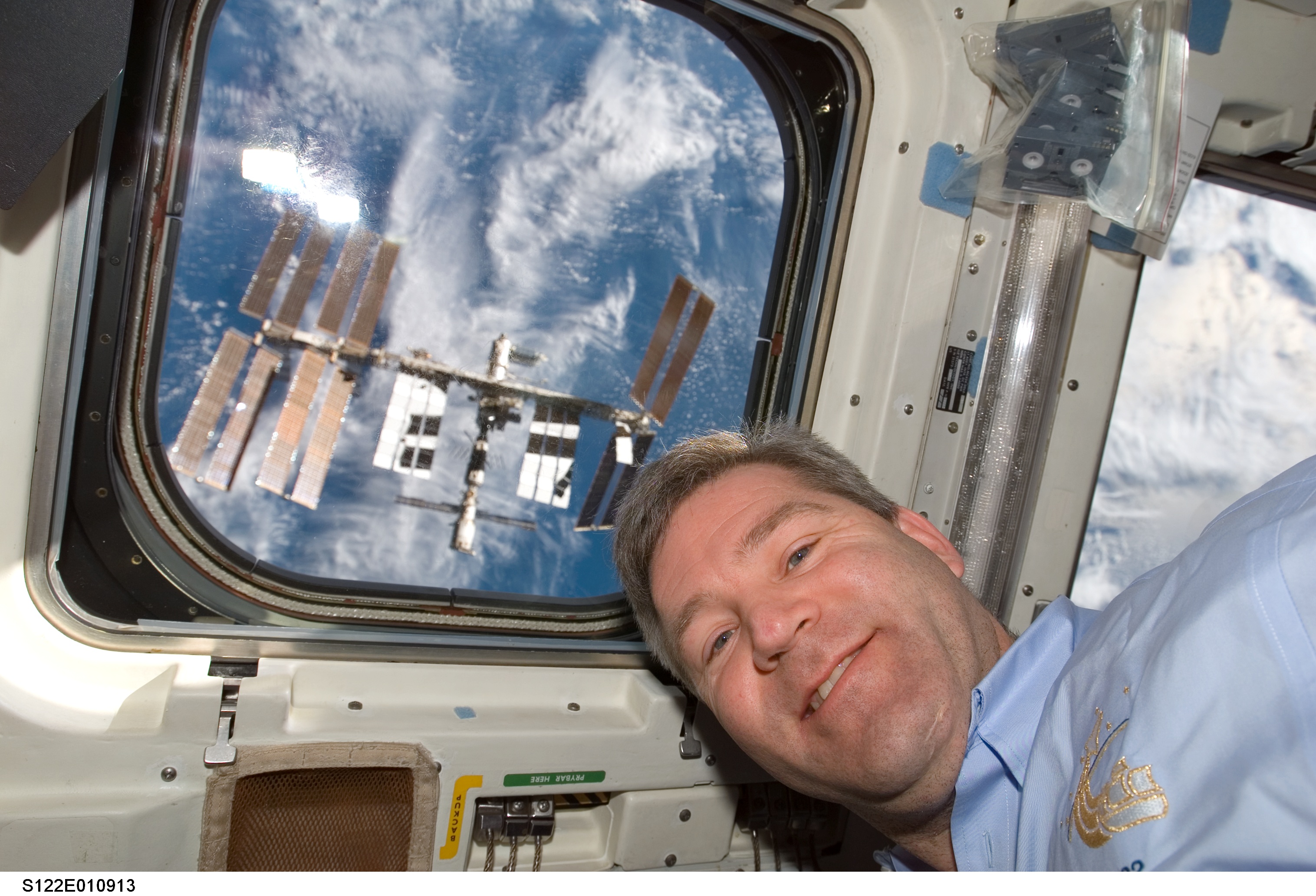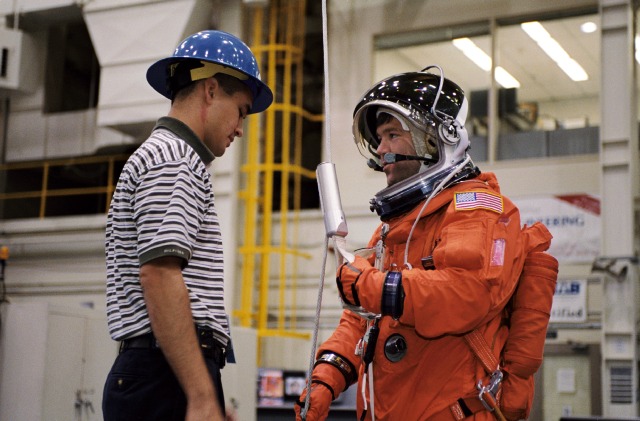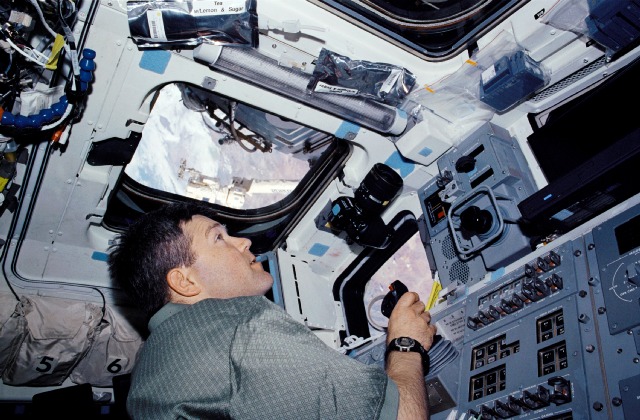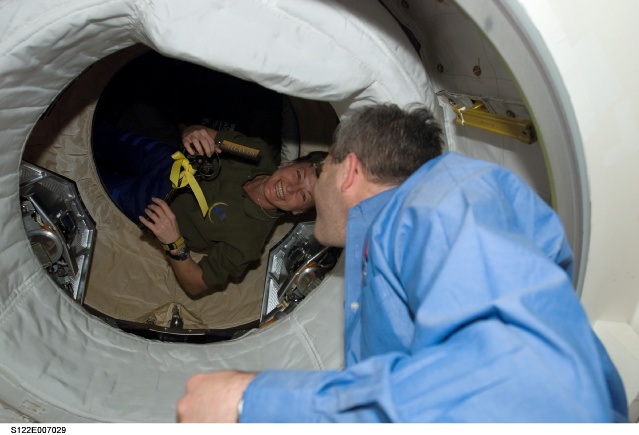
Five hundred years after the 1506 death of navigator and explorer Christopher Columbus, in the summer of 2006, a multi-national team of astronauts were appointed to shuttle mission STS-122, which would transport his spacefaring namesake—the European Space Agency’s (ESA) Columbus laboratory module—into low-Earth orbit and its permanent berth at the International Space Station (ISS). Named to command STS-122 was another navigator and explorer, Stephen Nathaniel Frick, a veteran shuttle pilot who today (Tuesday, 30 September) celebrates his 50th birthday and has helped to chart NASA’s next steps into deep space through his position as chief of the Astronaut Office Exploration Branch.
Born in Gibsonia, Penn., on 30 September 1964, Frick grew up in the Apollo and Skylab eras and by his own admission was “always” interested in spaceflight and, more generally, in aviation. Most of his family lived in the Gibsonia area—just to the north of Pittsburgh—and the young Frick clearly remembered the dark times of the steel industry crisis and the resultant economic depression, with its high levels of unemployment. Upon graduation from Richland High School in 1982, he entered the Naval Academy to study aerospace engineering and received his degree in 1986.
Frick was subsequently commissioned into the Navy and was designated a Naval Aviator in February 1988. He was initially assigned to Strike Fighter Squadron 106 at Naval Air Station Cecil Field, Fla., for transition to the F/A-18 Hornet, and later deployed to the Mediterranean and Rea Seas aboard the U.S.S. Saratoga to participate in Operations Desert Shield and Desert Storm. He flew 26 combat missions over Iraq and Kuwait and during this period was designated an airwing-qualified Landing Signals Officer.
Although the space program had long beckoned, the dream of becoming an astronaut was not all-consuming for Frick. He was keenly aware that it was virtually impossible to jump directly into such a career, but his naval experience was gradually guiding him toward NASA. In 1991, he was selected for a co-operative program with the Naval Postgraduate School in Monterey, Calif., and Naval Test Pilot School in Patuxent River, Md., which earned him a master’s degree in aeronautical engineering and qualification as a Naval Test Pilot in 1994. Frick next worked as a project officer and test pilot, performing shore-based and ship-based testing of the F/A-18, and was returning from a deployed squadron when he was selected as a shuttle pilot by NASA in April 1996.

“I had the basic requirements, so I put in an application and basically just got lucky,” he told an interviewer, years later. “I just had a little luck-of-the-draw opportunity there and was able to get in.” Following initial training and technical assignments, in April 2001 Frick was named as pilot of STS-110, an assembly mission to deliver the S-0 central truss segment and the Mobile Transporter (MT) to the space station. He was on vacation in England with his wife, Jennifer. “She had just finished her PhD,” Frick remembered, “and we were celebrating with a tour around some of the cathedrals in that area.” Upon returning to their hotel, they found a note from Chief Astronaut Charlie Precourt, asking if he would like to fly as pilot on STS-110. Needless to say, it was a question with only one answer, but for Frick the main problem was trying to find a telephone to call Precourt back and accept the offer.
A year later, the seven-strong STS-110 crew—with Mike Bloomfield in command, joined by Frick as pilot and mission specialists Rex Walheim, Ellen Ochoa, Jerry Ross, Steve Smith, and Lee Morin—arrived in Florida for a late afternoon launch aboard Shuttle Atlantis on 4 April 2002. However, during the effort to load the External Tank (ET) with cryogenic propellants on launch morning, a leak from a hydrogen vent line on the Mobile Launch Platform (MLP) was detected and the Mission Management Team elected to scrub the attempt and reschedule for 8 April instead. On this second occasion, despite a brief hold at T-5 minutes, all went well and Atlantis rocketed away from Pad 39B at 4:44:19 p.m. EDT, just 12 seconds before the closure of the launch window.
Powered for the first time by a full set of three Block II main engines—which boasted an improved high-pressure fuel turbopump with stronger integral shaft/disk and tougher-than-steel bearing, as well as the absence of welds to increase overall strength—the shuttle settled into an orbit of 220 statute miles (354 km), inclined 51.6 degrees to the equator, to kick off an ambitious 11-day mission. At 12:05 p.m. EDT on 10 April, with Mike Bloomfield controlling Atlantis from the aft flight deck and Steve Frick monitoring the maneuvering burns and handling the checklists, Atlantis docked at the ISS, high above southern China.
There was precious little time to admire their new environs, and after a short safety briefing by the station’s incumbent Expedition 4 crew of Commander Yuri Onufrienko and Flight Engineers Carl Walz and Dan Bursch, the STS-110 astronauts plunged into preparations for the installation of the 43-foot-long (13-meter) S-0 truss segment onto the ISS and the first of four planned EVAs. Ochoa and Bursch gingerly lifted the massive truss out of Atlantis’ payload bay with the station’s Canadarm2 robotic arm at 4:30 a.m. EDT on 11 April and maneuvered it onto a clamp atop the Destiny laboratory module. During the intricate, four-hour operation, Steve Frick worked to provide camera views to his crewmates with the shuttle’s own Remote Manipulator System (RMS) arm.

Shortly after the S-0 truss had been temporarily latched into place, at 10:36 a.m. astronauts Smith and Walheim ventured outside the Quest airlock on the first EVA of STS-110. They spent almost eight hours outside, installing the first two of an intended four mounting struts onto the truss, then deployed several trays of avionics and cables to provide power, data, and fluid connectivity with the rest of the station. The spacewalkers also hooked up an umbilical system from S-0 to the railcar-like MT, which would permit Canadarm2 to move along the truss structure for future assembly and repair tasks. Two days later, at 10:09 a.m. on 13 April, Ross and Morin departed the Quest airlock on a 7.5-hour EVA and successfully secured the final struts of S-0 onto Destiny.
During this period, Steve Frick executed the first of three “burns” of Atlantis’ Reaction Control System (RCS) thrusters to slowly reboost the ISS. Then, at 9:48 a.m. on 15 April, Smith and Walheim returned outside on the third spacewalk of STS-110 to release locking clamps from the MT and reconfigure electrical connectors to Canadarm2. Working from inside the shuttle’s cabin, Frick operated the RMS to maneuver Smith about his various worksites during the 6.5-hour EVA. Over the next few days, the MT railcar was commanded to move 32 feet (10 meters) along the truss to test its computers, drive motors, suspension unit, video and data capabilities, and the performance of the S-0 “rails.” It completed the exercise successfully, but fell foul to sensitive software and subtle effects of microgravity, which slightly lifted it from its rails and prevented the railcar from automatically latching itself to its worksite. However, manual commanding of the system proved effective.
The checkout of Canadarm2 took slightly longer than intended and Smith and Walheim were obliged to move their last task—the installation of a 14-foot (4.5-meter) ladder, known as the “Airlock Spur”—to the fourth and last EVA of the mission. Finally, at 10:29 a.m. on 16 April, Ross and Morin embarked on their 6.5-hour spacewalk to install the Airlock Spur, set up floodlights, and attach electrical converters and circuit breakers. With the completion of the EVA, STS-110 had accrued a total of 28 hours and 19 minutes of spacewalking time.
Although he was busy for much of STS-110, Frick hoped to catch a glimpse of his hometown, Gibsonia, whilst in orbit. Unfortunately, although the shuttle passed three times over the area during times when the crew was awake and could physically get to a window, weather conditions were overcast and Frick’s efforts were thwarted. At 12:27 p.m. EDT on 19 April, Atlantis returned safely to Earth, alighting on Runway 33 of the Shuttle Landing Facility (SLF) at the Kennedy Space Center (KSC).

Barely a few months later, the tragic loss of Columbia brought the shuttle program to its knees until mid-2005, and one of Frick’s duties during this period was as an Astronaut Office liaison to NASA Headquarters in Washington, D.C., and as lead Capcom for the STS-114 Return to Flight mission. In July 2006, he was named to command STS-122, joining pilot Alan Poindexter and mission specialists Leland Melvin, Stan Love, German astronaut Hans Schlegel, and his former STS-110 buddy, Rex Walheim. Later, as the ISS crewing manifest changed, they also picked up Frenchman Leopold Eyharts, who would be delivered to the space station for a long-duration expedition, with U.S. astronaut Dan Tani returning to Earth in his place.
Originally targeted for launch on 6 December 2007, STS-122 fell victim to a lengthy delay when two of the four liquid hydrogen Engine Cutoff (ECO) sensors—part of a redundant system which is responsible for shutting down the shuttle’s main engines if fuel levels ran unexpectedly low—failed to respond correctly. Initial hopes to fly on 8 December became untenable when one of the sensors failed again and after inspections and modifications the launch was rescheduled for 7 February 2008. Atlantis duly roared into orbit at 2:45 p.m. EST and Frick guided the shuttle to a smooth docking with the ISS at 12:17 p.m. EST on 9 February. Docking Day also happened to be the 48th birthday of the station’s incumbent skipper, Expedition 16 Commander Peggy Whitson, who had made no secret of the fact that she was excited to be receiving Columbus as a birthday gift.
The first EVA of the mission was originally to be performed by Walheim and Schlegel on 10 February, but was postponed by 24 hours, due to a “crew medical issue”—one possibility was a temporary loss of voice—which affected the German astronaut. The three spacewalks were intended to involve Walheim, Schlegel, and Love, and all three men had cross-trained on their respective tasks. It was therefore unsurprising that EVA-1 on 11 February was performed by Walheim and Love. The duo left the Quest airlock at 9:13 a.m. EST and spent eight hours helping to remove Columbus from Atlantis’ payload bay and assisted Canadarm2 operator Melvin to install it onto the station’s Harmony node.
Next day, the STS-122 and Expedition 16 crews began to activate the new module’s systems, switching on computers, power distribution units, and heaters, before Schlegel and Eyharts entered Columbus for the first time. Certainly, Schlegel’s temporary medical issue appeared to have been just that—temporary—and at 9:27 a.m. EST on 13 February he and Walheim set to work on the 6.5-hour EVA-2, successfully replacing a near-empty Nitrogen Tank Assembly (NTA). The third and final spacewalk, by Walheim and Love, began at 8:07 a.m. EST on 15 February and involved the installation of the Solar Monitoring Observatory (SOLAR) telescope and European Technology Exposure Facility (EuTEF) onto the end cone of Columbus, as well as the retrieval of a failed Control Moment Gyroscope (CMG). Their 13-day mission successfully concluded, Frick brought Atlantis to a textbook touchdown on Runway 15 of the SLF at 9:07 a.m. EST on 20 February.
In the aftermath of his second flight, Frick served as chief of the Exploration Branch of the Astronaut Office and retired from active Navy duty in September 2010, with the rank of Captain. In late 2011, he was assigned to the Naval Postgraduate School (NPS) in Monterey, Calif., as a professor in the Department of Mechanical and Aerospace Engineering, a position he currently holds. His wife, Dr. Jennifer Rhatigan, also works at the NPS as a NASA visiting professor, with a specialty in spacecraft thermal control, energy systems, combustion, and heat transfer.
Want to keep up-to-date with all things space? Be sure to “Like” AmericaSpace on Facebook and follow us on Twitter: @AmericaSpace



